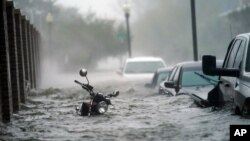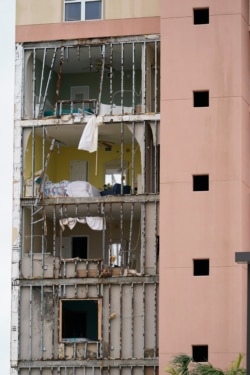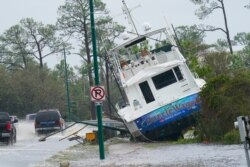A slow-moving Hurricane Sally, now a tropical storm, is pelting the Deep South of the United States with heavy rains and high winds, causing people to be trapped in floodwaters.
The storm made landfall Wednesday near Gulf Shores, Alabama.
“Historic and catastrophic flooding, including widespread moderate to major river flooding, is unfolding,” the National Hurricane Center said.
According to The Associated Press, Sally damaged boats, felled palm trees, blew the roofs off some houses and left more than 500,000 without power.
By Wednesday afternoon, the storm had been downgraded to a tropical storm with winds of 110 kph, but the rain may be the bigger threat as the storm was moving at only 7 kph.
In Florida, Escambia County Sheriff David Morgan said the rains would likely require thousands to flee the area because of rising waters over the next few days.
"There are entire communities that we’re going to have to evacuate,” he told the AP. “It’s going to be a tremendous operation over the next several days.”
Escambia authorities announced a dusk-to-dawn curfew for the next three days. They also said there have been 377 rescues from water-stricken areas.
The amount of rain is devastating, with nearby Pensacola Naval Air Station reporting 61 centimeters of precipitation and downtown Pensacola seeing almost a meter of rain.
It’s not common to measure rain in these amounts, forecaster David Eversole told the AP.
“Sally’s moving so slowly, so it just keeps pounding and pounding and pounding the area with tropical rain and just powerful winds. It’s just a nightmare,” Eversole said.
Ed Rappaport, deputy director of the National Hurricane Center, compared Sally to 2017’s Hurricane Harvey, which soaked Houston with rain for days and flooded much of the city.
“Sally has a characteristic that isn’t often seen and that’s a slow forward speed, and that’s going to exacerbate the flooding,” Rappaport told the AP.
Florida Governor Ron DeSantis issued a state of emergency for several counties.
Heavy rains are also expected as far north as parts of Virginia and North and South Carolina.
Sally may also lead to tornadoes across portions of the Florida Panhandle, southern Alabama and southwestern Georgia.
President Donald Trump issued emergency declarations for parts of Louisiana, Mississippi and Alabama, and he tweeted that residents should listen to state and local leaders.
Sally is the second storm to hit the Gulf Coast in less than three weeks.


